"Alec Issigonis, who would create the most iconic piece of fully realized automotive design of the 1960s, was born in the Greek port of Smyrna in 1906. He was the descendent of at least two generations of passionate engineers, but there "

Art Fitzpatrick: Original Mad Man
Art Fitzpatrick created in his work for the advertising campaigns of American car companies some of the key images of the chrome-clad dream of the American automobile. Influx caught up with an irrepressible artist who helped define the way that the post war motorcar was created and consumed – now entering his tenth creative decade while the American auto industry shudders from the closure of one of the brands he helped create: Pontiac.
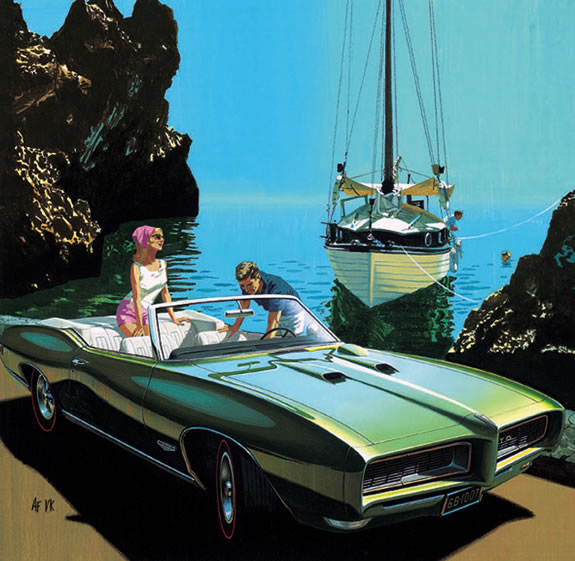
Influx Magazine: Your work seems to encapsulate American dreams of affluence and success as represented by the motorcar. How conscious were you when you were creating the work that you were selling the American Dream?
Art Fitzpatrick: I can’t remember when the “American Dream” became a capitalized term, but I don’t recall it ever being used in any business meeting that I attended. However, what we were doing was just that, selling it. I was always conscious of it. I’m a born firm believer that image is the primary factor in the purchase of an automobile, and every piece of evidence; research, anecdotal, or historical, reinforces my conviction. You’ll never see smoking tires in my ads! An occasional car in motion, but no smoking tires.
IM: What was the commissioning process?
AF: Up until my 1953 contract with Buick, I used an agent … the commissioning process was my getting orders for car paintings through my agent. For the next 20 years the commissioning for each piece of art work consisted of my being told individually, or by a list, of single or double page ads, and what model car (Bonneville (sedan, convertible, wagon) Grand Prix, Tempest, etc.). Colour and view of car, scene, activity, night or day, etc. was left up to me. Once in a while some ambitious copywriter would offer a truly helpful suggestion, like spelunking (cave exploration!!!), which I would either ignore, or if really flabbergasted, caustically comment on.
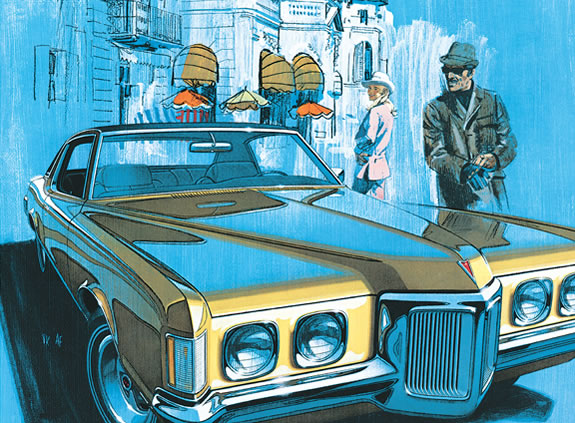
IM: How tight a brief did you receive from the manufacturers?
AF: None, other than to be technically correct, although I understood that, knowing my work would be reviewed after completion for technical accuracy, like having the proper number of headlights, or “streamline the keyhole cover”. I forgot, the brief from S.E. “Bunkie” Knudsen at Pontiac was basically to transform their image from that of a “3rd grade school teacher’s car” to one that was “socially acceptable”. It went from 7th place in sales to 3rd place in less than 2 years.
IM: Did you exaggerate the dimensions of the cars you were drawing?
AF: I prefer to use the term “enhanced”. I once wrote a piece for GM (when “Truth in Advertising” became a concern of the U.S. Senate) on this subject. I photographed a car … same position/view with 3 different lenses, 35, 50, and 120mm. Photographers, for reasons that continue to escape me, were using long lenses, which shorten a car, making the rear wheel look bigger then the front ones. I always used a 35mm lens (wide angle). I made a pencil line drawing of an exact tracing of 35mm photo, and on another sheet over that did my “enhancing”. Every one it was tested on thought my “exaggerated” drawing looked more like the car than the exact tracing, and way more so than the 120mm lens photo.
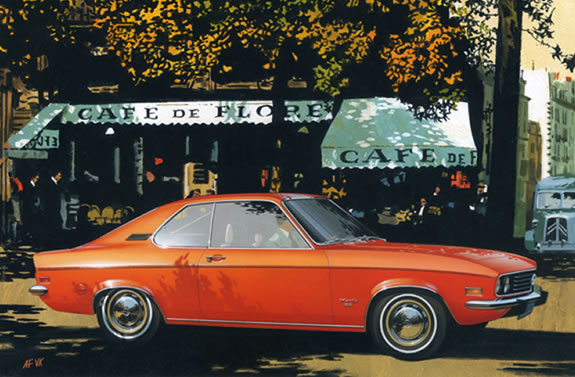
IM: Did you visit respective locations you used with the cars and create the work from life?
AF: It’s pretty hard to get a car parked in front of a café in Venice! That’s true of most of our pictures. We shot all the locations then I shot the all of car photos on a turntable from a “cherry picker” bucket at the GM Tech Centre, or in my own driveway. I had company cars, most of the time 3 of them. I only bought (at dealers’ price) 4 cars in my 20 years with GM.
IM: Were you properly compensated for your work?
AF: At the time, we couldn’t believe they were paying us all this money to have so much fun. In retrospect, to paraphrase Automobile Quarterly, ” If, indeed, a picture is worth a thousand words, those illustrations were worth millions to the coffers of General Motors”, now I’d now say we were underpaid!
IM: How would you characterise the changes in the work between the late forties and the seventies?
AF: I’m not sure whether you are asking about my work, or car advertising in general. Mine improved as demand for my services increased my control of the choices of colour, including the cars, the car views, and the subject matter, from no background to complex illustrations. Doing as many as 5 different car ad campaigns at the same time pushed my creativity to make subtle differences in style and technique in how I painted cars.
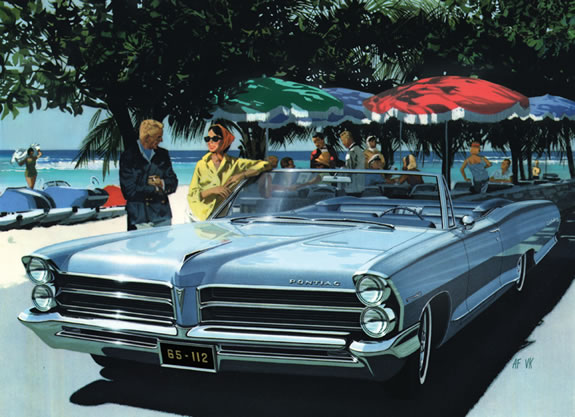
IM: Do you think there will ever be room again for glamour in the selling of the motorcar?
AF: The title to one of my talks is “What Happened to the Pizzazz?” I deal with the starkly visible difference between what we were doing in 1973 and generally in auto advertising since then. I’m no longer privy to today’s readership research results, but I’d sure like to know what it’s saying, because it has all looked so much alike since then. One of the main reasons for that is the computer, both in the design of the cars, and illustrating them for ads. The photographers put the artists out of business, and the computer put them out of business. The cars all look very much alike on the road, and the ads all look the same on the web, on TV, or in a magazine or newspaper. The ad look is the result of being able to take a car designed on a computer, rotate it to any view desired, and cover it with a grey (read “silver”) skin. So, no photo, no painting, no figures (people), no background (other than some vague, computer generated shape or swoosh). So, no glamour, no class, no emotion of any kind. Recent research says 47% of car shoppers say #1 reason for selection is image, prestige … still by far the largest group, and as for brand loyalty, about that same percentage will leave a dealership and switch to another make if they can’t find the colour they want!
About 15 years ago when Toyota was contemplating a luxury car line they did a tremendous amount of research before picking up a pencil to create a car. They used Mercedes as their benchmark, dissecting both the car and its customers. #1 reason by far for buying … image, prestige … #4 was performance.
Their history book for what became Lexus doesn’t bother stating what #2 & #3 reasons were. The fact that they didn’t bother to mention them is as interesting as their identity and rank. So unless we are all reduced (for whatever reasons) to driving Smart cars, yes, there has to be room for glamour.
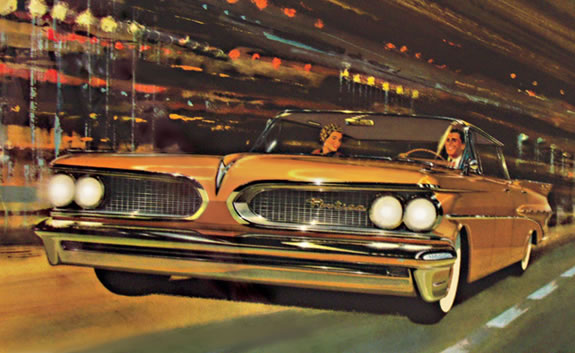
CLICK TO ENLARGE










5 Responses to “Art Fitzpatrick: Original Mad Man”